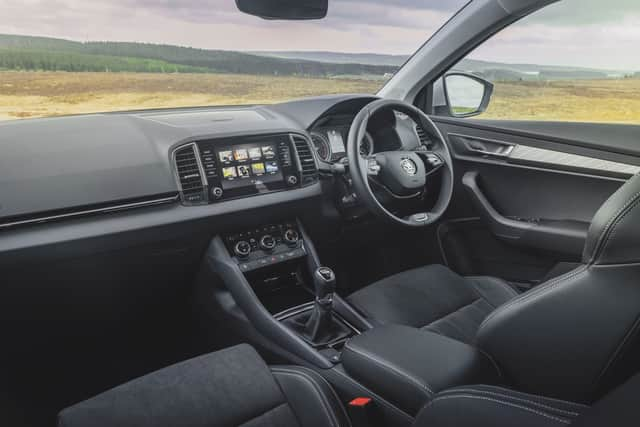MOTORS REVIEW: Skodas Karoq


While it is over a foot shorter than the larger, seven-seat Kodiaq in old money, its unapologetically square-set stance delivers a spacious interior with good headroom and great access to a gaping 521-litre boot.
What is more, the rear seats are three individual units which can slide fore and aft, folded or totally removed to create a space with enough space to assault a refuse centre with 1,810-litres of recycling.
Advertisement
Hide AdAdvertisement
Hide AdUshered in with the new-for-2022 are subtle design tweaks to the bumpers, the introduction of sleeker LED headlights and rear light clusters and the option of seats clad in recycled plastic bottles.
Skoda offers a choice of three petrol and two diesel engines with power outputs ranging from 110PS to 190PS and the option of a DSG dual-clutch gearbox and four-wheel-drive on certain derivatives.
I drove the mid-grade option in a Karoq line-up comprised of SE Drive, SE L and Sportline trim lines, with prices start at £25,505.
Equipped with a 1.5-litre 150PS petrol engine and six-speed manual gearbox, our test car came in at £30,660.
Advertisement
Hide AdAdvertisement
Hide AdThat is not the budget territory that the Skoda of old might have been renowned for.
However, the level of kit and quality that has arguably proved a point of contention in VW as Skoda threatened the brands above it.


In SE L guise there are those LED lights, cruise control, an eight-inch Amundsen sat nav infotainment system with a reversing camera and a year’s web connectivity included, stylish Alcantara-style seat coverings and all the safety acronyms on the spec sheet. Step out of line and it will beep at you.
Of course, it would not be a Skoda without a few quirky, practical tools thrown in for good measure.
Advertisement
Hide AdAdvertisement
Hide AdHere we got the mini ice scraper inside the fuel cap door and an umbrella under the passenger seat. Nice touches.
Similar attention to detail has been paid to making the Karoq more efficient in its latest guise.
Aerodynamic wheels – 18-inches on my SE L test car – and undertrays that divert air more cleanly under the car have helped to cut drag.
The Volkswagen Group’s 1.5 TSI EVO engine, meanwhile, cuts two of its four cylinders to save energy under light loads.
Advertisement
Hide AdAdvertisement
Hide AdThe result is a drivetrain that claims 42.8 to 43.5mpg fuel economy and 147 to 151g/km CO2 emissions.
It is also capable of an 8.8 second dash to 62mph and a 131mph top speed, Skoda claims.
The latter stats feel less believable than the former, which I emulated during my time with the Karoq.
As I have experienced in other VW products, the 1.5 TSI unit is truly multi-talented, but does not serve up its energy readily.
Advertisement
Hide AdAdvertisement
Hide AdDespite being turbocharged, it does not quite have the guts to ride out a very high third gear at lower speeds and needs revs to deliver meaningful urge.
What is more, I found I could audibly detect when the Karoq shut two of its cylinders down, a slight boomy reverberation entering the otherwise refined cabin. This was a muted and minor issue, however.
The Karoq is a practical and purposeful SUV, though, and proved a great long-distance cruiser, even if its dynamics remains somewhat on the staid side.
Like I said at the start, if people are truly wanting to make the transition for added space and practicality, then this is well worthy of consideration.
I suspect, however, that most do it for kudos and it might be that tall, square-set Czech family car is a little too conservative for some.